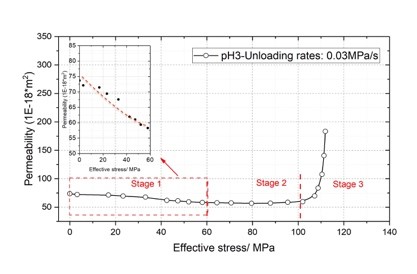[Geotechnical Engineering]
Experimental Investigation of the Permeability and Mechanical Behaviours of Chemically Corroded Limestone Under Different Unloading Conditions[J]. Rock Mechanics and Rock Engineering. 2019.
Keywords: Nuclear magnetic resonance (NMR) Micro damage Hydrochemical–mechanical coupled effects Unloading Permeability
High Lights:
Nuclear Magnetic Resonance (NMR) tests are carried out to quantify the chemical damage of limestone samples.
The relationship between permeability and mechanical behaviors of the rock under hydro-chemical-mechanical coupled effects is investigated.
An stress-permeability (ESP) model is proposed
Abstract:
This paper investigates the mechanical properties and permeability of chemically corroded rock during deep underground tunnelling. Nuclear Magnetic Resonance (NMR) tests are carried out to quantify the chemical damage of limestone samples at the microscopic scale. Coupled hydrostatic pressure-unloading tests at different unloading rates are also conducted on these chemically corroded limestone samples to investigate permeability changes and chemical effects on mechanical behaviours. Magnetic Resonance Imaging (MRI), T2 spectrum distribution and porosity of the samples are obtained, and the chemical micro damage is visualized and quantified. The relationship between permeability and mechanical behaviors of the rock under hydro-chemical-mechanical coupled effects is investigated. Results show that the permeability development process of the chemical corroded samples can be divided into three stages: at the first stage, the permeability initially decreases, and the second stage starts at the inflection point of the permeability curve, from where the permeability begins to increase slightly. At the third stage, the permeability of the limestone increases dramatically until the sample is ruptured. Chemical corrosion and unloading rates have a combined and significant influence on the development of micro cracks in rocks, which is the root cause of the permeability changes. An stress-permeability (ESP) model is proposed to describe permeability and stresses in chemical corroded limestone; this can be adopted for other sedimentary rocks.
Resource:https:// link.springer.com/article/10.1007/s00603-019-01961-y#citeas
